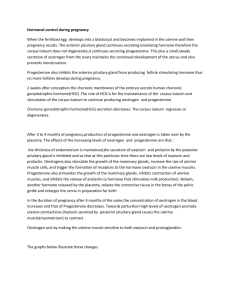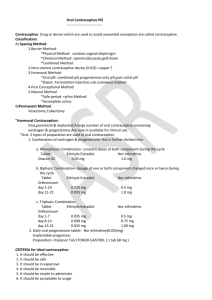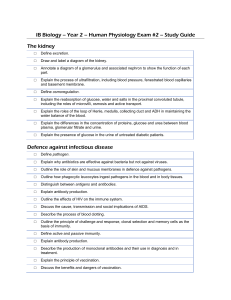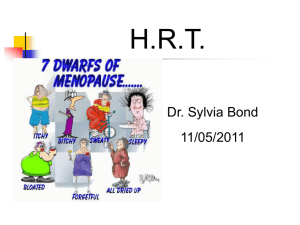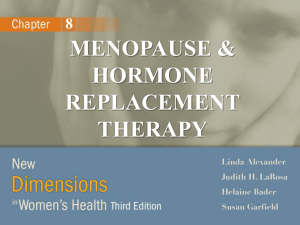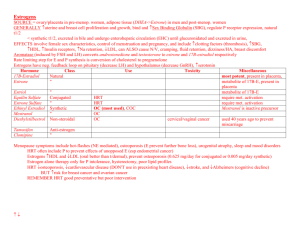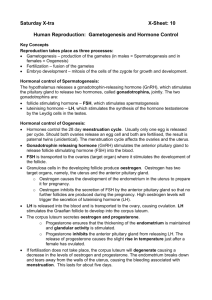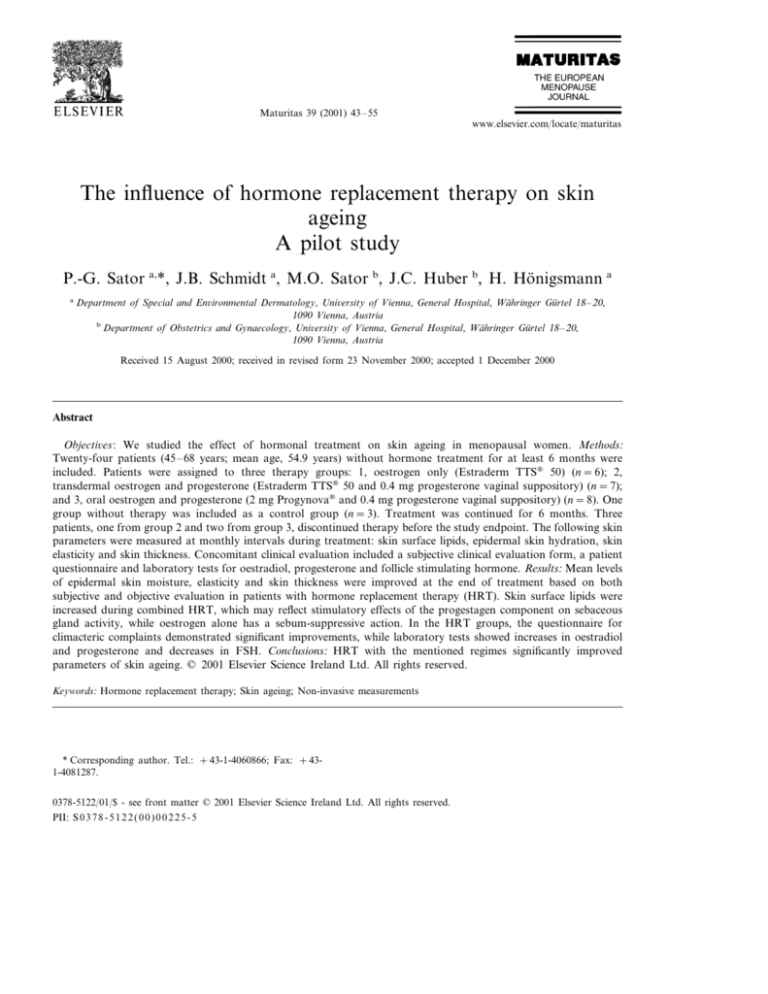
Maturitas 39 (2001) 43 – 55
www.elsevier.com/locate/maturitas
The influence of hormone replacement therapy on skin
ageing
A pilot study
P.-G. Sator a,*, J.B. Schmidt a, M.O. Sator b, J.C. Huber b, H. Hönigsmann a
a
Department of Special and En6ironmental Dermatology, Uni6ersity of Vienna, General Hospital, Währinger Gürtel 18 – 20,
1090 Vienna, Austria
b
Department of Obstetrics and Gynaecology, Uni6ersity of Vienna, General Hospital, Währinger Gürtel 18 – 20,
1090 Vienna, Austria
Received 15 August 2000; received in revised form 23 November 2000; accepted 1 December 2000
Abstract
Objecti6es: We studied the effect of hormonal treatment on skin ageing in menopausal women. Methods:
Twenty-four patients (45–68 years; mean age, 54.9 years) without hormone treatment for at least 6 months were
included. Patients were assigned to three therapy groups: 1, oestrogen only (Estraderm TTS® 50) (n= 6); 2,
transdermal oestrogen and progesterone (Estraderm TTS® 50 and 0.4 mg progesterone vaginal suppository) (n = 7);
and 3, oral oestrogen and progesterone (2 mg Progynova® and 0.4 mg progesterone vaginal suppository) (n = 8). One
group without therapy was included as a control group (n= 3). Treatment was continued for 6 months. Three
patients, one from group 2 and two from group 3, discontinued therapy before the study endpoint. The following skin
parameters were measured at monthly intervals during treatment: skin surface lipids, epidermal skin hydration, skin
elasticity and skin thickness. Concomitant clinical evaluation included a subjective clinical evaluation form, a patient
questionnaire and laboratory tests for oestradiol, progesterone and follicle stimulating hormone. Results: Mean levels
of epidermal skin moisture, elasticity and skin thickness were improved at the end of treatment based on both
subjective and objective evaluation in patients with hormone replacement therapy (HRT). Skin surface lipids were
increased during combined HRT, which may reflect stimulatory effects of the progestagen component on sebaceous
gland activity, while oestrogen alone has a sebum-suppressive action. In the HRT groups, the questionnaire for
climacteric complaints demonstrated significant improvements, while laboratory tests showed increases in oestradiol
and progesterone and decreases in FSH. Conclusions: HRT with the mentioned regimes significantly improved
parameters of skin ageing. © 2001 Elsevier Science Ireland Ltd. All rights reserved.
Keywords: Hormone replacement therapy; Skin ageing; Non-invasive measurements
* Corresponding author. Tel.: + 43-1-4060866; Fax: + 431-4081287.
0378-5122/01/$ - see front matter © 2001 Elsevier Science Ireland Ltd. All rights reserved.
PII: S 0 3 7 8 - 5 1 2 2 ( 0 0 ) 0 0 2 2 5 - 5
44
P.-G. Sator et al. / Maturitas 39 (2001) 43–55
1. Introduction
Like all other tissues, skin undergoes degenerative processes during ageing. Although skin ageing is associated with increased rates of skin
disorders and skin tumours, and sometimes with
psychological distress caused by a deterioration in
appearance, the main focus of public medicine is
not on skin ageing but on other age-associated
chronic disorders such as arthritis, heart disease
and cancer [1,2]. At present, most women in
developed societies can expect to spend one-third
or more of their lifetime in the postmenopausal
period [2]. Skin ageing, therefore, becomes increasingly important; it is still a matter of debate,
however, whether hormone replacement therapy
(HRT) also improves the various symptoms of
skin ageing in postmenopausal women.
The effects of HRT on the skin have not been
studied in detail despite the importance of dermatological aspects of ageing in this population [3–
6].
Cutaneous ageing is the result of a combination
of chronological and environmental (e.g. nicotine,
pollution, UV-induced ageing) factors, and hormonal ageing [7].
Skin is a target organ for various hormones.
Hormonal action requires the binding of the hormone to specific receptors. Oestrogen receptors as
well as other hormone receptors have been isolated and characterized in the human skin [8].
Oestrogen receptors are to be found in skin structures associated with skin ageing processes. A
decrease in oestrogen influences might thus induce
a reduction of those skin functions that are under
oestrogen control.
In clinical terms, many females experience a
sudden onset of skin ageing symptoms several
months after menopause. One of the first symptoms of skin ageing women experience after
menopause is an increase in skin dryness, followed by a decrease in skin firmness and elasticity. The increasing looseness of the skin outweighs
other symptoms such as wrinkles at that stage of
reduced hormonal action. These symptoms correspond to changes in collagenous and elastic fibres
that have been reported to be due to oestrogen
deficiency [9]. A significant decrease in skin colla-
gen starting at the menopause has been demonstrated [1]. Among the various types of collagen,
types I and III are of major relevance [10]. Both
types of collagen change during the ageing process. Type I collagen represents the predominant
collagen type in adult human skin, whereas type
III collagen, also widely distributed throughout
the body (being the second most frequent collagen
in the adult human skin), predominates in tissues
of foetuses. Oestrogens stimulate the synthesis,
maturation and turnover of collagen, increase the
synthesis of hyaluronic acid, and promote water
retention [11].
In view of these findings, we performed the
present ad hoc pilot study, comparing the effects
of three different forms of HRT on various
parameters of skin ageing.
2. Materials and methods
2.1. Patients
Twenty-four menopausal women aged 45–68
years (mean age, 54.9 years), who had received no
hormonal treatment for a minimum of 6 months,
who had been amenorrhoeic for at least half a
year and whose bone density values were within
the normal range, were included in the study. On
average, the study participants were 8.2 years
after their last menstrual period (0.5–30 years).
Further menopausal criteria were their initial hormone levels: low oestradiol (E2) (B 45 pg/ml) and
high follicle stimulating hormone (FSH) (\ 30
mU/ml) serum levels (Table 1). Of the 24 patients,
eight had undergone a hysterectomy and three an
oophorectomy. The probands were female volunteer outpatients who had been referred to our
centre from the gynaecological department and
who had all given their informed consent to the
treatment and the investigations.
2.2. Study design and treatment
In this ad hoc study, the effects of three different HRT regimes on different parameters of skin
ageing were compared over a period of 6 months.
The patients were assigned to four groups: group
Group 1
E2 (pg/ml)
FSH (mU/ml)
Progesterone (ng/ml)
Mean
S.D.
Mean
S.D.
Mean
S.D.
Group 2
Group 3
Group 4
Before therapy
After 6 months
P
Before therapy
After 6 months
P
Before therapy
After 6 months
P
Before therapy
After 6 months
P
29.43
13.29
45.98
15.42
0.29
0.22
45.83
23.04
40.13
14.03
0.31
0.29
0.12
n.s.
0.25
n.s.
0.59
n.s.
16.33
7.63
63.15
34.94
0.29
0.28
49.80
46.83
43.68
20.18
1.93
2.26
0.08
n.s.
0.08
n.s.
0.04
25.83
21.21
69.52
15.31
0.37
0.28
59.33
34.10
50.12
26.41
0.82
0.68
0.08
n.s.
0.08
n.s.
0.25
n.s.
37.33
28.50
35.13
23.75
0.47
0.27
18.00
5.57
41.93
19.03
0.24
0.25
n.s.
n.s.
n.s.
a
Group 1, Estraderm TTS 50; group 2, Estraderm TTS 50+0.4 mg progesterone vaginal suppository; group 3, 2 mg Progynova+0.4 mg progesterone vaginal suppository; group 4, control group. P50.05, Statistically
significant difference between before therapy and after 6 months (analyzed with a Wilcoxon test). n.s., not significant; S.D., standard deviation.
P.-G. Sator et al. / Maturitas 39 (2001) 43–55
Table 1
Initial and final hormone levelsa
45
46
P.-G. Sator et al. / Maturitas 39 (2001) 43–55
1, oestrogen (oestradiol) alone (Estraderm TTS®
50) (n= 6; age, 51– 68 years; mean age, 58.7
years); group 2, oestrogen (oestradiol) transdermally and progesterone (Estraderm TTS® 50 and
0.4 mg progesterone vaginal suppository) (n = 7;
age, 48–58 years; mean age, 54.4 years); group 3,
oestrogen (oestradiol) orally and progesterone (2
mg Progynova® and 0.4 mg progesterone vaginal
suppository) (n=8, age, 45– 59 years; mean age,
52.5 years); and group 4, without therapy, as a
control group (n=3; age, 50– 65 years; mean age,
55 years). Due to the discontinuation of treatment
by one patient in group 2 and by two patients in
group 3, six patients remained in each group with
HRT. Taking this fact into account, the mean
time that had elapsed since the last menstrual
period was 8.8 years (S.D., 10.9) in group 1, 8.2
years (S.D., 7.1) in group 2, 8.9 years (S.D., 6.8)
in group 3 and 7.8 years (S.D., 4.6) in group 4.
Two patients in group 1 had had previous HRT,
while three women each in groups 2 and 3 and
one patient in group 4 had a history of hormone
replacement therapy. In all of these cases, however, HRT had been terminated at least half a
year before.
The study was a longitudinal study with ad hoc
data. Patients were randomly assigned to treatment groups based on the order of presentation.
The female volunteers were rotationally assigned
to groups 1, 2, 3 or 4. There were women who
were not prepared to forego treatment and who
were therefore assigned to the therapy group resulting from the randomization list. That is why
the control group (group 4) consisted only of
three test persons. To facilitate comparisons, all
patients were treated between October and April;
likewise, to exclude diurnal variations, measurements were performed at 14:00 h in all patients.
Dosing instructions were as follows: Estraderm
TTS® 50 patches (Ciba-Geigy, Basel, Switzerland)
given every 3–4 days; 2 mg Progynova® (Schering, Vienna, Austria), once daily; 0.4 mg progesterone vaginal suppositories, 10 days per month.
2.3. Measurement methods
Skin properties were measured by non-invasive
methods to evaluate the effects during various
systemic hormone replacement treatments. The
following skin properties were measured monthly:
skin surface lipids, epidermal skin moisture, skin
elasticity and skin thickness (epidermis and
dermis).
Measurements were performed under standardized conditions, i.e. a room temperature of 21°C
and a humidity level of 40–45%. Prior to the
measurements, patients were given 2 h to adapt to
room conditions without covering the measurement sites by clothes. Patients were instructed not
to use cosmetics on examination days. The measurement sites were selected to include both UVexposed
and
non-exposed
sites.
The
measurements were always performed by the same
investigator. Mean values of multiple measurements were determined to avoid measuring inaccuracies. Women were advised not to change their
cosmetic regimen (emollients) 3 months prior to
and during HRT. Cosmetic compounds with antiageing effects (such as retinoic acid, glycolic acid,
tretinoin, ascorbic acid or hormonal compounds)
were not allowed.
The Sebumeter® SM 810 (Courage+Khazaka
Electronic GMBH, Cologne, Germany) was used
for quantitative measurements of skin surface
lipids composed of sebum and corneal lipids. The
device consists of a fat-stain photometer that
measures the level of light transmission of a plastic sheet coated with sebum. The method is insensitive to humidity. A probe is pressed on to the
skin region under investigation for 30 s at a
constant pressure of 9.4 N/cm2. The Sebumeter
measures the variation of light transmission
through the strip. The change in sheet transparency is computed and the result displayed in units
that can then be converted into micrograms per
square centimetre [12,13]. The variation of light
transmission is proportional to the quantity of
lipids absorbed. Three sites were studied: forehead, inner side of the right upper arm, and the
suprasternal region — all of them were kept free
from garments prior to the measurements.
The Corneometer® CM 820 (Courage+ Khazaka Electronic GMBH, Cologne, Germany) determines the humidity level of the stratum corneum
by measuring electrical capacitance. Alterations of
epidermal skin hydration result in a change in
P.-G. Sator et al. / Maturitas 39 (2001) 43–55
capacitance of the measuring condensator. The
probe is applied to the skin for 1 s at a pressure of
7.1 N/cm2. The degree of epidermal skin humidity
is indicated in system-specific units [9,12–14]. One
unit represents a water content of stratum
corneum of 0.02 mg/cm2, according to a measuring depth of 20 nm. Measurements were performed on three sites: left temporal bone, inner
side of the left upper arm, and the suprasternal
region.
Dermaflex A® (Cortex Technology ApS,
Hadsund, Denmark) is a device for the rheologic
measurement of skin elasticity based on a vacuum-induced elevation of skin, which is represented by the following factors: tensile
distensibility (measured as the maximum skin elevation after one suction (mm)), elasticity (measured and calculated as the degree of total
retraction after one suction (%)) and hysteresis
(measured as the increase in maximum skin elevation in the last suction minus the distensibility
(mm)). The measurement data depend on the
composition of elastic and non-elastic structures
of the skin. The main criterion is elasticity, which
is defined as: (tensile distensibility-resilient distension)× 100%/tensile distensibility. Tensile distensibility reflects the collagen fibres, and resilient
distension (the resultant elevation of the skin after
release of the first suction) reflects the elastic
fibres. The hysteresis parameter reflects the water
content, the dominating viscous component of
skin rheology, which determines the skin turgor.
The measurements were performed as follows:
magnitude of suction in the probe with a 150
mbar vacuum; number of suctions in the measurement preselected at 6 times, with each measuring
cycle consisting of a suction and release phase
lasting 6 s. Measurements were performed at the
right mandibular region, the inner side of the
right upper arm, and the suprasternal region.
Osteoson® D III (Minhorst GmbH & Co,
Meudt, Germany) is a high-frequency ultrasound
system for the measurement of skin thickness
(epidermis and dermis) [12,15]. The probe has a
frequency of 25 MHz and a bandwidth of 8 MHz,
and measures the skin at a depth of up to 5 mm.
The results are imaged both in an A-scan and a
B-scan mode. The A-scan units represent the re-
47
ceived ultrasound echo signals as a one-dimensional amplitude diagram displayed against time.
All two-dimensional procedures are called B-scan
procedures [16]. For the purpose of the present
study, the distance between the first two tension
amplitudes, i.e. between the interface of air-exposed epidermis and the dermal-subcutaneous fat
tissue layer, was chosen [15]. An echogenic band
caused by the entry echo (or epidermis/gel interface) is representing the epidermis. Due to limited
axial resolution, normal epidermis cannot always
be viewed separately. That is why the total thickness of the epidermis and dermis was measured
[17]. Ultrasound was chosen to measure skin
thickness, given that it is a highly precise method
for this purpose [18]. Measurements were performed at the inner side of the left upper arm in
order to exclude UV-induced influences on skin
ageing.
In addition, clinical evaluation was performed
at monthly intervals. This consisted of a questionnaire for climacteric complaints (Klimax Score)
and for skin symptoms. The Klimax Score includes the following parameters: 1, psychovegetative symptoms: hot flushes, disturbed sleep,
nervousness, fatigue, depression, libido reduction,
palpitation, paresthesiae, dizziness, forgetfulness,
headache; 2, atrophical symptoms: vaginal dryness, incontinence, arthralgia, myalgia, skin dryness, dry eyes; 3, progestagen-deficiency
symptoms: breast tenderness, migraine, oedema.
The intensity of symptoms was classified as follows: 0 = none, 1= slight, 2= moderate, 3= distinct. Moreover, each patient’s skin was
monitored clinically according to a personal evaluation scheme at monthly intervals for the following criteria: skin dryness, skin tension,
desquamation, slackness of skin, turgor, firmness,
elasticity, moisture, and skin lipids. For this, the
following evaluation scheme was used: (–) none,
(+ ) minor, (+ + ) moderate, (+ + + ) marked
and (+ + + + ) very marked change.
Blood tests for oestradiol, follicle stimulating
hormone and progesterone were performed by
routine radioimmunoassay methods [19] before
therapy and at 3-monthly intervals. A gynaecological examination and bone densitometry were
performed before therapy.
48
P.-G. Sator et al. / Maturitas 39 (2001) 43–55
Bone density screening was performed using a
Hologic QDR-1000™ X-ray bone densitometer
(Hologic, USA) based on the DXA measuring
method. Sites of measurements were lumbar vertebrae [1–4]. Only patients with bone density
values within the normal range were included in
the study.
0.05 was considered significant and P 50.01 was
considered highly significant.
2.4. Statistical methods
When only oestrogen was given (i.e. without
progesterone), we observed a significant decrease
in skin lipids (except in the suprasternal region
where the decrease was not significant). The
largest decrease was found at the inner side of the
upper arm. In contrast, the combination of
oestrogen plus progesterone resulted in a significant increase in skin surface lipids. The largest
increase was detected in the group receiving 2 mg
Progynova plus 0.4 mg progesterone vaginal suppository. The control group showed no significant
changes (Table 2 and Fig. 1). The difference in
The data were analysed using the SPSS (Superior Performing Software Systems) for Windows
Release 8.00 (1997) program. Due to the small
sample size, a normal distribution could not be
assumed. A parametric test could not be applied
either. Therefore, the Wilcoxon signed-rank test
was used instead of a parametric test. For comparisons between groups, the H-test by Kruskal–
Wallis was used, which compared the groups in a
multivariant mode for significant differences. P 5
3. Results
3.1. Skin surface lipids
Fig. 1. Skin surface lipids: suprasternal.
Table 2
Measurementsa
Group 1
Group 2
Group 3
Group 4
After 6 months
P
Before therapy
After 6 months
P
Before therapy
After 6 months
P
Before therapy
After 6 months
P
Mean
S.D.
Mean
S.D.
Mean
S.D.
154.33
44.27
43.83
76.09
26.17
22.13
133.83
43.68
5.33
7.28
18.67
13.62
0.03
129.83
42.46
1.83
0.75
33.33
23.00
163.00
42.31
5.00
2.10
53.00
23.10
0.03
152.67
57.44
2.00
1.79
28.33
12.34
210.67
46.39
10.33
8.73
57.17
17.08
0.03
111.33
37.17
11.00
7.21
64.67
39.80
119.67
13.43
5.00
5.20
28.67
19.40
n.s.
Mean
S.D.
Mean
S.D.
Mean
S.D.
72.22
7.98
61.67
2.35
80.85
9.25
86.90
3.60
85.06
6.32
91.55
5.70
69.22
12.36
63.55
9.31
83.68
5.84
84.28
6.49
78.48
6.13
92.48
2.39
0.03
71.35
9.23
64.05
10.18
77.95
11.97
82.45
9.85
75.38
8.46
90.40
5.09
0.03
Inner side of the
Left upper arm
Suprasternal
Region
63.00
7.05
73.37
4.73
86.23
5.28
73.00
3.38
70.53
5.69
85.90
4.16
Elasticity (%)
Mandibular region
Right side
Inner side of the
Right upper arm
Suprasternal
Region
Mean
S.D.
Mean
S.D.
Mean
S.D.
51.67
11.41
34.33
5.24
41.17
9.41
66.67
8.94
41.50
5.54
62.33
13.71
42.17
11.87
36.50
3.27
49.67
9.03
61.17
12.53
45.50
5.17
59.50
5.17
0.03
50.67
7.00
39.67
8.16
45.33
9.73
67.50
9.87
55.83
5.71
65.50
11.38
0.03
54.67
10.97
56.00
18.25
64.33
22.14
48.33
6.81
39.00
10.15
57.67
15.28
Skin thickness (mm)
Inner side of the
Left upper arm
Mean
S.D.
Sebumetry (units)
Frontal
Inner side of the
Right upper arm
Suprasternal
Region
Corneometry (units)
Frontal
0.906
0.154
1.118
0.124
0.04
0.22
n.s.
0.03
0.03
0.03
0.03
0.03
0.03
0.03
0.900
0.099
1.030
0.097
0.04
0.05
0.03
0.05
0.03
0.03
0.03
0.891
0.094
1.046
0.065
0.04
0.03
0.03
0.03
0.03
0.03
0.03
0.848
0.106
0.881
n.s.
n.s.
n.s.
n.s.
n.s.
n.s.
n.s.
n.s.
P.-G. Sator et al. / Maturitas 39 (2001) 43–55
Before therapy
n.s.
a
Group 1, Estraderm TTS 50; group 2, Estraderm TTS 50+0.4 mg progestrone vaginal suppository;group 3, 2 mg Progynova+0.4 mg progesterone vaginal suppository; group 4, control group. P50.05, Statistically
significant difference between before therapy and after 6 months (analyzed with a Wilcoxon test). n.s., Not significant; S.D., standard deviation.
49
P.-G. Sator et al. / Maturitas 39 (2001) 43–55
50
Fig. 2. Epidermal hydration: suprasternal.
baseline values between group 4 and the other
groups can be seen from the descriptive data. It is
not measurable significantly by statistical methods, however, on account of the small sample size
in group 4.
3.2. Epidermal hydration
Epidermal moisture showed comparable significant increases in all HRT groups after 6 months
of treatment at all measuring sites. The increase
was comparable in all HRT groups for all measuring sites (Fig. 2). The largest increase in hydration was observed at the inner side of the upper
arm in patients taking only oestrogen. There were
no significant changes in the control group.
3.3. Skin elasticity
Skin elasticity was significantly improved after
6 months of HRT. The increases were smaller at
the inner side of the upper arm than at the
mandibular region and the suprasternal region
(Fig. 3). The changes in the control group were
not significant.
A comparison of the measurements of epidermal hydration and skin elasticity revealed no significant differences between UV-exposed and
non-exposed measurement sites.
3.4. Skin thickness
Skin thickness increased significantly in all hormonally treated groups as compared with the
control group. The mean value of skin thickness
in all HRT groups increased at a highly significant
level of 0.17 mm after 6 months of HRT (P=
0.0002) (Fig. 4).
P.-G. Sator et al. / Maturitas 39 (2001) 43–55
51
3.5. Clinical efficacy
3.6. Hormone le6els
The Klimax Score demonstrated significant improvements of clinical symptoms in all hormonally treated groups.
Clinically, improvements of skin dryness, skin
tension, desquamation, slackness of the skin, turgor, firmness, elasticity and moisture were observed with HRT. In patients receiving HRT, a
reduction of skin lipids was observed after 6
months, except for the Estraderm TTS® 50 and
0.4 mg progesterone vaginal suppository group
(Table 3).
In most cases, the largest increases in subjective
and clinical improvements were observed between
the third and fourth months of treatment. A
clinically significant improvement of skin dryness
and elasticity became evident at the end of
treatment.
The evaluation of hormone serum levels (serum
oestradiol, follicle stimulating hormone and
progesterone) showed increases in oestradiol and
progesterone and decreases in FSH in all treatment groups during HRT (Table 1). The results
were not significant with the exception of the rise
in progesterone in group 2.
3.7. Ad6erse effects
In group 1, three patients complained of temporary breast tenderness, and one of local reddening
at the application site of the hormone patches.
One patient each complained about transient
breast tenderness in groups 2 and 3. Local reddening caused by the patch was observed in group
2.
Fig. 3. Skin elasticity: suprasternal.
52
Table 3
Clinical changesa
Group 1
2 Skin tension
3 Desquamation
4 Slackness of the
skin
5 Turgor
6 Firmness
7 Elasticity
8 Moisture
9 Skin lipids
Group 3
Group 4
Before therapy
After 6 months
P
Before therapy
After 6 months
P
Before therapy
After 6 months
P
Before therapy
Mean
S.D.
Mean
S.D.
Mean
S.D.
Mean
3.67
0.82
3.00
1.10
1.67
1.86
2.50
1.25
1.29
0.75
1.17
0.17
0.41
1.25
0.03
2.75
1.33
2.17
1.60
0.83
1.17
2.42
1.17
1.13
0.75
1.17
0.33
0.82
1.50
0.03
2.67
0.52
2.33
1.21
1.33
0.82
2.50
0.58
0.49
0.50
0.55
0.00
0.00
0.92
0.03
3.67
0.58
3.00
0.00
1.67
1.53
2.00
3.00
1.73
2.67
1.53
1.33
1.53
2.17
S.D.
Mean
S.D.
Mean
S.D.
Mean
S.D.
Mean
S.D.
Mean
S.D.
1.38
1.50
0.55
1.50
0.55
2.00
0.89
0.17
0.41
1.50
1.22
1.08
2.75
0.88
2.75
0.88
3.67
0.52
1.00
0.89
0.83
0.75
1.36
1.67
0.82
1.67
0.82
1.83
0.75
1.00
1.10
1.00
1.26
1.00
2.67
0.52
2.83
0.75
3.00
0.89
2.17
1.17
1.00
1.10
0.55
2.00
0.63
2.00
0.63
2.17
0.75
1.17
0.75
2.17
1.33
0.66
3.17
0.98
3.33
1.03
3.33
0.82
2.33
1.63
1.67
1.21
0.00
2.33
0.58
1.67
0.58
1.67
0.58
0.67
0.58
1.00
1.73
1.76
2.00
1.00
1.67
0.58
1.67
1.15
2.00
1.00
11.00
19.05
0.03
0.04
0.07
n.s.
0.02
0.02
0.41
n.s.
0.10
n.s.
0.10
n.s.
0.04
0.08
n.s.
0.07
n.s.
0.07
n.s.
0.07
n.s.
0.04
0.04
1.00
n.s.
0.03
0.04
0.04
0.06
n.s.
0.07
n.s.
0.07
n.s.
0.10
n.s.
0.41
After 6 months
P
n.s.
n.s.
n.s.
n.s.
n.s.
n.s.
n.s.
n.s.
n.s.
a
Group 1, Estraderm TTS 50; group 2, Estraderm TTS 50+0.4 mg progesterone vaginal suppository; group 3, 2 mg Progyno6a+0.4 mg progesterone 6aginal suppository; group 4, control group. 0, No change; 1, minor
change; 2, moderate change; 3, marked change; 4, very marked change. P50.05, Statistically significant difference between before therapy and after 6 months (analyzed with a Wilcoxon test). n.s., Not significant; SD,
standard deviation.
P.-G. Sator et al. / Maturitas 39 (2001) 43–55
1 Skin dryness
Group 2
P.-G. Sator et al. / Maturitas 39 (2001) 43–55
53
Fig. 4. Skin thickness: upper arm inside.
4. Discussion
In the present study, the clinical finding of
beneficial HRT effects on skin ageing symptoms
were substantiated by objective measurements,
whereas we did not detect any significant changes
in the control group.
The finding of increased skin surface lipids
during combined HRT may reflect stimulatory
effects of the progestagen component on sebaceous gland activity, in contrast to oestrogen
alone having a sebum-suppressive activity [20–
22].
The amount of sebum on the skin surface
reflects the size and density of the sebaceous
glands. It is largest on the forehead and decreases
in the following order: chest, back, abdomen,
upper and lower limbs [23]. An increase in sebum
secretion with HRT (oestradiol plus various
progestagens) has been previously reported by
Callens et al. [12] and Pierard [22]. However, a
distinct influence of progestagens on skin ageing
has not been described [8]. Our findings suggest
that a decrease in sebum production during
menopause may be alleviated by a course of combined HRT (oestrogen plus progesterone) [24].
This might be relevant to atopic patients, who
might benefit from increased epidermal lipids. It is
also important to note that hormonally increased
sebum production may be of relevance in acneprone skin, and that this may be the reason for
acne flares in predisposed females undergoing
HRT. Although acne flares were not observed in
our study, skin lipid increases indicate such a
possibility and it is imperative for hormone substitution to be carefully adapted to each patient’s
specific situation.
An additional aspect of hormonal effects on
connective tissue was obtained by measuring skin
elasticity. Comparable significant increases in
54
P.-G. Sator et al. / Maturitas 39 (2001) 43–55
elasticity were observed in all treatment groups by
month 6 of HRT, which is indicative of the
positive effects of various kinds of HRT on tensile
skin functions.
In addition, our study demonstrates significant
improvements after 6 months of treatment not
only of elasticity, but also of epidermal hydration
in all patients receiving HRT, a finding which is in
agreement with clinical observations by Dunn et
al. [25]. In contrast, Callens et al [12] and Jemec
and Serup [26] found no modification of superficial skin hydration in patients receiving HRT.
The lack of significant differences between the
increase in epidermal hydration and elasticity during HRT in UV-exposed and non-exposed sites of
the skin is of great importance because it suggests
that, in certain aspects, photoaged skin may
benefit from hormonal treatment in a similar way
as UV-protected aged skin. Our results are in
accordance with the study of Henry et al. [27].
Epidermal and dermal thickness, the structure
of elastic fibres, the skin vessels and the dermal
mucopolysaccharide acid content are important
markers for the progression of skin ageing. All
these parameters are under oestrogen influence
[9].
Our results show a highly significant increase in
skin thickness (epidermal and dermal thickness) in
hormonally treated postmenopausal women after
a 6-month treatment period. In addition, our
clinical observations suggest that HRT (particularly in patients with 2 mg Progynova® with 0.4
mg progesterone vaginal suppository) may diminish teleangiectasia, which were less visible, possibly due to increased epidermal thickness.
A leading parameter of skin ageing is skin
thickness, which reflects the status of the collagen
and elastic tissue. Punnonen and Rauramo [28]
showed significant increases in both skin collagen
and thickness during HRT in a histological investigation. Their findings were supported by Brincat
et al. [29], who showed a positive correlation
between bone collagen and skin collagen, both
decreasing after menopause and increasing during
HRT. Using ultrasound, the authors demonstrated an increase in epidermal and dermal thickness a few weeks after the start of systemic
oestrogen substitution therapy. Moreover, a re-
cent study demonstrated the action of oestrogen
on dermal components such as collagen, elastic
fibres, water content, hyaluronic acid and fibroblasts [12].
Increases in skin thickness were also reported
by other authors who used ultrasound [7,12,15]
and other measuring techniques [29,30]. Our
study, in which ultrasound, a sensitive, reproducible and valid technique for measurements of
skin thickness [15,18], was used, supports these
results. In contrast, one large cross-sectional study
reported that oestrogen use was associated with
thinner skin (by calibre assessment) [31].
The clinical improvements of the various skin
properties during HRT were in accordance with
the measurement data. Especially with oestrogen
alone, the use of cosmetic creams was reduced,
although the skin surface lipids decreased. This
finding confirms the increase in epidermal hydration during oestrogen treatment. Other positive
findings noted by the patients were a moderate
reduction of wrinkles and an increased firmness of
the skin at the end of the treatment period.
There were only minor side effects of HRT and
they consisted of breast tenderness, and of local
reddening at the application site of the hormone
patches in some of the patients.
HRT was shown to significantly improve
parameters involved in skin ageing in this preliminary study. In most cases, hydration, elasticity
and skin thickness were significantly increased.
These findings support the clinical impression that
an early hormone substitution therapy may restore the initial features of hormonally induced
skin ageing. Whether HRT will be able to delay
the onset of skin ageing in general or to alleviate
the severity of its symptoms will be subject to
further research.
References
[1] Castelo-Branco C, Duran M, Gonzalez-Merlo J. Skin
collagen changes related to age and hormone replacement
therapy. Maturitas 1992;15:113 – 9.
[2] Kligman AM, Koblenzer C. Demographics and psychological implications for the aging population. Dermatol
Clin 1997;15:549 – 53.
P.-G. Sator et al. / Maturitas 39 (2001) 43–55
[3] Pierard GE, Letawe C, Dowlati A, Pierard-Franchimont
C. Effect of hormone replacement therapy for
menopause on the mechanical properties of skin. J Am
Geriatr Soc 1995;43:662 –5.
[4] Campbell S, Whitehead M. Oestrogen therapy and the
menopausal
syndrome.
Clin
Obstet
Gynaecol
1977;4:31 – 47.
[5] Stampfer MJ, Colditz GA, Willett WC, et al. Postmenopausal estrogen therapy and cardiovascular disease: ten-year follow-up from the nurses’ health study.
N Engl J Med 1991;325:756 –62.
[6] Bolognia JL, Braverman IM, Rousseau ME, Sarrel PM.
Skin changes in menopause. Maturitas 1989;11:295 – 304.
[7] Creidi P, Faivre B, Agache P, Richard P, Haudiquet V,
Sauvanet JP. Effect of a conjugated oestrogen (Premarin®) cream on ageing facial skin. A comparative
study with a placebo cream. Maturitas 1994;19:211 – 23.
[8] Schmidt JB, Lindmaier A, Spona J. Hormone receptors
in pubic skin of premenopausal and postmenopausal females. Gynecol Obstet Invest 1990;30:97 –100.
[9] Schmidt JB, Binder M, Macheiner W, Kainz Ch, Gitsch
G, Bieglmayer Ch. Treatment of skin ageing symptoms
in perimenopausal females with estrogen compounds. A
pilot study. Maturitas 1994;20:25 –30.
[10] Schmidt JB, Binder M, Demschik G, Bieglmayer C,
Reiner A. Treatment of skin aging with topical estrogens. Int J Dermatol 1996;35:669 –74.
[11] Epstein EH, Munderloh NH. Isolation and characterization of CNBr peptides of human [a1 (III)]3 collagen
and tissue distribution of [a1 (III)]3 collagens. J Biol
Chem 1975;250:9304 –12.
[12] Callens A, Vaillant L, Lecomte P, Berson M, Gall Y,
Lorette G. Does hormonal skin aging exist? A study of
the influence of different hormone therapy regimes on
the skin of postmenopausal women using non-invasive
measurement techniques. Dermatology 1996;193:289 –94.
[13] Wilhelm K-P, Cua AB, Maibach HI. Skin aging-effect
on transepidermal water loss, stratum corneum hydration, skin surface pH, and casual sebum content. Arch
Dermatol 1991;127:1806 –9.
[14] Pierard-Franchimont C, Letawe C, Goffin V, Pierard
GE. Skin water-holding capacity and transdermal estrogen therapy for menopause: a pilot study. Maturitas
1995;22:151 – 4.
[15] Serup J. Ten years experience with high-frequency ultrasound examination of the skin: development and refinement of technique and equipment. In: Altmeyer P,
el-Gammal S, Hoffmann K, editors. Ultrasound in Dermatology. Berlin: Springer, 1992. pp. 41 – 54.
[16] Kreitz G. A- and B-scan techniques of conventional
ultrasound units. A survey. In: Altmeyer P, el-Gammal
S, Hoffmann K, editors. Ultrasound in Dermatology.
Berlin: Springer, 1992:12 –21.
.
55
[17] Vaillant L, Berson M, Machet L, Callens A, Pourcelot
L, Lorette G. Ultrasound imaging of psoriatic skin: a
non-invasive technique to evaluate treatment of psoriasis. Int J Dermatol 1994;33:786 – 90.
[18] Tan CY, Statham B, Marks R, Payne PA. Skin thickness measurement by pulsed ultrasound: its reproducibility, validation and variability. Br J Dermatol
1982;106:657 – 67.
[19] Reinthaller A, Kirchheimer JC, Deutinger J, Bieglmayer
C, Christ G, Binder BR. Plasminogen activators, plasminogen activator inhibitor and fibronectin in human
granulosa cells and follicular fluid related to oocyte
maturation and intrafollicular gonadotropin levels. Fertil Steril 1990;54:1045 – 51.
[20] Pochi PE, Strauss JS. Effect of cyclic administration of
conjugated equine oestrogens on sebum production in
women. J Invest Dermatol 1966;47:582 – 5.
[21] Pochi PE, Kligman AM. The effects of androgens and
estrogens on human sebaceous glands. J Invest Dermatol 1962;39:139 – 55.
[22] Pierard GE. The quandary of climacteric skin ageing.
Dermatology 1996;193:273 – 4.
[23] Wüst H, Suhrholt H. Untersuchungen über den Einfluß
anaboler Hormone und O8 strogene auf die Hauttalgsekretion des Menschen. Hautarzt 1965;16:514 – 8.
[24] Pochi PE, Strauss JS, Downing D. Age-related changes
in sebaceous gland activity. J Invest Dermatol
1979;73:108 – 11.
[25] Dunn LB, Damesyn M, Moore AA, Reuben DB,
Greendale GA. Does estrogen prevent skin aging? Results from the first national health and nutrition examination survey (NHANES I). Arch Dermatol
1997;133:339 – 42.
[26] Jemec GBE, Serup J. Short-term effects of topical 17-boestradiol on human postmenopausal skin. Maturitas
1989;11:229 – 34.
[27] Henry F, Pierard-Franchimont C, Cauwenbergh G,
Pierard G. Age-related changes in facial skin contours
and rheology. J Am Geriatr Soc 1997;45:220 – 2.
[28] Punnonen R, Rauramo L. Effect of estrogen therapy on
climacteric symptoms and tissue chances. Acta Obstet
Gynecol Scand 1974;53:267 – 9.
[29] Brincat M, Moniz CJ, Studd JWW, et al. Long-term
effects of the menopause and sex hormones on skin
thickness. Br J Obstet Gynaecol 1985;92:256 – 9.
[30] Punnonen R, Vilska S, Rauramo L. Skinfold thickness
and long-term post-menopausal hormone therapy. Maturitas 1984;5:259 – 62.
[31] Maheux R, Naud F, Rioux M, et al. A randomized,
double-blind, placebo-controlled study on the effect of
conjungated estrogens on skin thickness. Am J Obstet
Gynecol 1994;170:642 – 9.


